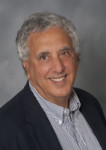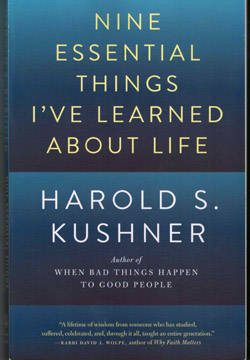Nine Essential Things I’ve Learned About Life by Harold S. Kushner; Anchor Books (c) 2015; IBSN 9780804-173452; 171 pages, $15.
By Donald H. Harrison

 SAN DIEGO — Rabbi Harold Kushner, famous since he wrote When Bad Things Happen to Good People, has a personal ritual which I found fascinating. “Before I sit down to write, I make out a check to one of the charitable causes we support. … preparing myself for the challenge of being creative by doing an act of kindness and generosity, thereby defining myself as a certain kind of person, and that perspective would flavor my writing.”
SAN DIEGO — Rabbi Harold Kushner, famous since he wrote When Bad Things Happen to Good People, has a personal ritual which I found fascinating. “Before I sit down to write, I make out a check to one of the charitable causes we support. … preparing myself for the challenge of being creative by doing an act of kindness and generosity, thereby defining myself as a certain kind of person, and that perspective would flavor my writing.”
How different the rabbi is from, say, columnist Jimmy Breslin, New York City’s Pulitzer Prize winning columnist who, according to legend, would power up with coffee and cigarettes before writing a column. It was said he would take three styrofoam cups of coffee and stack them on his desk, then drink the first one, smoke a cigarette, drink a second one, smoke another cigarette, and so on, while the story took shape in his thoughts. When he finished the last cigarette, his hands would explode onto his typewriter’s keyboard and he would type the story without pause—it having already been worked out in his head.
Wow! Watching Kushner or Breslin compose would be quite an experience. As for me, I have no such ritual. I summon a blank sheet of computer space, stare at it, and then start writing, correcting and deleting as I go, and sometimes rewriting before I can put -30 – at the bottom of the page. The numeral thirty, as some old newspaper types will remember, was derived from XXX, which was the symbol that teletype operators would utilize to signify a break between one story and another. San Diegans may remember that the late Gloria Penner of KPBS used to have a weekly show called “That’s 30” in which local news reporters would discuss the important stories that they covered. Eventually, it was decided the name was too esoteric and it was changed to “San Diego Week in Review” or something equally prosaic.
While I don’t have a ritual to compare with Kushner’s nor Breslin’s before setting words to paper (or perhaps more properly bytes to receptors), I do have a ritual that helps me to read books, whether they be tips to live by, such as Kushner’s, steamy novels, or more staid biographies.
I put a checkmark at the top of a page containing a passage that has struck me as interesting (yes, I write in books, though minimally) and another check mark by the intriguing paragraph in question. In a separate, small notebook, I keep a log of the page numbers that I have checked. For me, Kushner’s book proved particularly check-worthy at pages 12, 18, 21, 24, 43, 48, 67, 69, and 85. No doubt other readers would find different passages equally thought provoking.
On Page 21, Kushner launched into a discussion of the Sh’ma prayer, which we all learn by rote: “Hear O Israel, the Lord our God, the Lord is one!”
Kushner writes: “If we have a picture of God as a man, does that mean God is a man and not a woman, and that men are more similar to God than women are? If God in your picture is old, should you worry that God might not understand the problems that you face as a young person? If God in your picture has white skin, should a child with black or brown skin, or an Asian child, feel that he or she is less close to God than white-skinned, blue-eyed children?”
After some more exegesis, Kushner goes on to write: “When I proclaim: ‘The Lord is one,’ as I do daily in my prayers, I’m not making a mathematical statement. It is not a report of the population of divine beings in heaven. It is a theological statement … It is the insistence that God embraces all polarities, male and female, young and old, scolding and forgiving. Everything—all polarities—finds its place in God. ‘God is one’ means something like ‘God is all.’”
I’d never thought of the Sh’ma prayer that way before; but I will from now on!
The context within which Kushner told about his writing ritual was a story about a woman who came to him feeling that she had nothing left to live for. He counseled her, as he had counseled others, that to find true meaning in her life, she might dedicate herself to helping others. Others have written that the act of helping others causes endorphins to be released in our blood stream, providing a sense of happiness and accomplishment. Kushner tells us that religion is not simply a matter of belief or feeling, it is a matter of actualizing what intuitively we know is good behavior.
Religion is the good that flows between people, he explains. So when Kushner prepared himself to write by making a charitable contribution, no matter what organization was named on his check, this was a religious act.
I have alluded to only a couple of the gems in the rabbi’s book. I believe I’ve done you an act of kindness by leaving most of his book for you to explore by yourself, or even better, to share with a reading group.
*
Harrison is editor of San Diego Jewish World. He may be contacted via donald.harrison@sdjewishworld.com. Comments intended for publication in the space below MUST be accompanied by the letter writer’s first and last name and by his/ her city and state of residence (city and country for those outside the United States.)